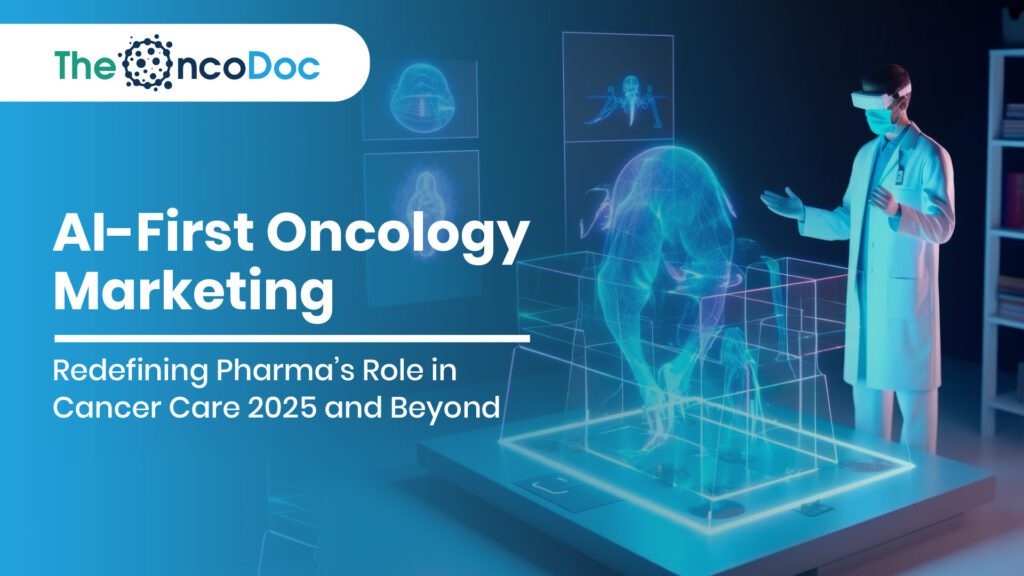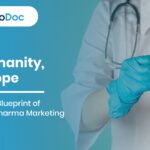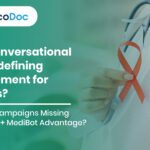Introduction: From Awareness to Intelligent Impact
Oncology is undergoing a revolution where data, empathy, and intelligence converge. Pharma marketing, once defined by prescriber outreach and product promotion, is now pivoting to something far greater, building ecosystems of early detection, education, and emotional connection.
The combination of artificial intelligence (AI), precision medicine, and digital-first engagement is transforming how stakeholders, from patients and caregivers to oncologists and policymakers, interact with cancer care. In this new paradigm, marketing is not about selling molecules, but about delivering hope, improving outcomes, and reducing disparities.
This article explores the new frontier of oncology pharma marketing: where AI-driven personalization, trust-building, and community integration create a blueprint for the next decade.
1. The Shift Toward Empathy-Driven AI Campaigns
Cancer is not just a medical diagnosis; it is an emotional life disruption. Traditional pharma ads often highlighted survival statistics and scientific jargon, but today’s audiences demand authenticity and human connection.
AI enables marketers to analyze emotional cues from patient feedback, social listening, and online support groups. Campaigns can now be adapted in real time, whether to offer reassurance, address anxiety, or counter misinformation.
- AI tools track emotional sentiment across digital platforms.
- Survivor voices are integrated into targeted awareness campaigns.
- In order to promote empowerment and lessen narratives based on fear, messaging has been modified.
The result is not just higher engagement but also stronger trust equity for pharma brands.
2. Hyper-Personalization with Genomic and Lifestyle Data
Personalization in oncology marketing has moved beyond demographics. AI now incorporates genomic profiles, biomarker data, and lifestyle factors to tailor outreach.
- Patients with BRCA1/2 mutations may receive specific awareness material about PARP inhibitors.
- Smokers in rural regions could be nudged toward oral cancer screenings through localized WhatsApp campaigns.
- Younger urban patients might get content about fertility preservation during chemotherapy.
Pharma marketers who integrate genomics with behavioral data are positioning themselves as partners in precision medicine, rather than mere drug providers.
3. Engaging General Practitioners (GPs) with Digital Nudges
GPs remain the critical first point of cancer suspicion. However, due to limited oncology exposure, many miss early signs. Pharma marketing is stepping in with AI-powered GP enablement tools.
- Bite-sized CME modules delivered via WhatsApp.
- AI chatbots that provide instant guidance on whether a referral is warranted.
- Interactive infographics and diagnostic decision trees.
Such interventions ensure that early diagnosis campaigns succeed at the grassroots level, reducing delays in referral and treatment initiation.
4. Emotional Storytelling at Scale with AI
Cancer narratives resonate when they feel personal and authentic. AI now helps identify and amplify survivor stories most likely to move audiences to action.
For example:
- Millennial women may be encouraged to seek early screening if a young breast cancer survivor shares her experience with fertility.
- The narrative of a rural survivor can encourage oral cancer screenings in rural communities.
By combining AI-curated storytelling with video-first platforms, pharma brands are moving beyond education into community-driven impact.
5. Omnichannel Marketing Reimagined
Oncology audiences consume content across multiple touchpoints, TikTok reels, WhatsApp alerts, hospital kiosks, and telemedicine apps. A successful oncology campaign in 2025 ensures channel harmony:
- Pre-diagnosis stage: symptom awareness videos via Instagram.
- Diagnosis stage: oncologist-led explainers via webinars.
- Treatment stage: adherence nudges via wearable-connected apps.
- Survivorship stage: community forums supported by pharma.
This end-to-end omnichannel flow reflects the reality that oncology marketing is now a continuum, not a campaign.
6. Behavioral Science Meets AI
Human behavior often dictates cancer outcomes more than science alone. AI allows marketers to apply behavioral triggers at scale:
- Loss aversion nudges: “Skipping your mammogram increases late detection risk by 70%.”
- Gamified rewards: communities earn points for hosting screening camps.
- Anchoring techniques: framing survival rates with early detection to boost screening uptake.
Studies show these nudges can increase screening participation by up to 30%, creating measurable health impact.
7. New Metrics: Moving Beyond Vanity to Value
Click-through rates no longer define oncology marketing success. Instead, health-first KPIs are the new benchmark.
These metrics shift pharma’s role from product promoters to health enablers.
8. Voice and Vernacular Marketing for Inclusivity
In oncology marketing, inclusivity is as critical as innovation. Many regions with limited literacy or digital literacy face barriers in accessing cancer-related information. Voice-first AI campaigns are now emerging as powerful tools to bridge this gap and ensure no patient is left behind.
- IVR helplines in regional languages such as Hindi, Bengali, and Tamil provide simple, step-by-step answers to common cancer symptoms and FAQs.
- Voice-enabled WhatsApp bots help patients schedule screenings and consultations effortlessly, even without typing skills.
- Smart speakers in rural clinics and health centers broadcast awareness messages, reminders for checkups, and survivor stories in local dialects.
By using the language people understand and the medium they trust most – voice, pharma companies are successfully expanding cancer awareness to marginalized communities. This strategy not only increases participation in screenings but also plays a vital role in reducing inequities in oncology care delivery.
9. Survivor-Led Communities as Authentic Influencers
Pharma brands are increasingly investing in digital survivor clubs where patients, caregivers, and doctors interact.
- Members share experiences and treatment journeys.
- Clubs host webinars and local awareness camps.
- AI tools analyze discussion trends to identify patient concerns.
The peer-to-peer trust factor makes these survivor-led communities more impactful than celebrity endorsements.
10. AI-Powered Social Listening to Counter Misinformation
In the digital age, misinformation about cancer treatments often spreads faster than authentic medical guidance, creating confusion and mistrust. To address this, AI-powered social listening has become a crucial tool in oncology pharma marketing, enabling brands to safeguard public understanding and trust.
- Detecting myths in real time: AI algorithms scan millions of online conversations to quickly identify misleading claims, such as “herbal cures for cancer” or conspiracy-driven narratives.
- Deploying counter campaigns: Once detected, pharma teams can launch targeted responses featuring verified oncologists, survivor testimonials, and fact-based videos to debunk myths effectively.
- Monitoring emotional tone: AI doesn’t just analyze content, it evaluates emotions behind conversations, allowing marketers to refine messaging that reassures, educates, and uplifts rather than alarm.
By combining speed, accuracy, and empathy, social listening ensures oncology campaigns remain scientifically reliable, emotionally sensitive, and culturally relevant, protecting patient communities from misinformation-driven harm.
11. Integrating Wearables into Cancer Awareness
Smartwatches and other wearable technology are now more than just fitness monitors. They are now part of AI-driven preventive oncology marketing.
- Step count and sleep pattern anomalies trigger awareness nudges.
- Sudden weight loss notifications link to cancer screening reminders.
- Wearables sync with pharma apps for personalized educational prompts.
This integration bridges the gap between daily lifestyle and preventive oncology.
12. AI-Driven Predictive Campaigns
One of the most powerful evolutions is predictive oncology marketing.
- AI scans search engine spikes for “lump in breast” or “chronic cough.”
- Geo-mapping tools identify at-risk districts.
- Campaigns are launched in real time, with localized survivor stories.
This makes marketing proactive, not reactive, ensuring early intervention.
13. Partnerships with NGOs and Governments
Pharma-led cancer awareness achieves scale when paired with public health networks.
- Free screening camps co-hosted with state health ministries.
- AI chatbots are used by ASHA employees to teach in rural areas.
- NGO collaborations for low-cost survivorship support programs.
Such partnerships bring legitimacy and inclusivity, aligning commercial goals with societal good.
14. AR/VR for Medical and Patient Education
Immersive technologies are reshaping both oncologist training and patient education.
- Oncologists practice tumor resections via VR simulations.
- Patients see 3D representations of how therapies target cancer cells, easing anxiety.
- Pharma companies sponsor AR-based CME sessions.
This creates experiential learning, boosting both physician confidence and patient trust.
15. Post-Treatment Engagement for Survivorship
Cancer care doesn’t end with remission. Pharma brands are building holistic survivorship ecosystems.
- Nutritional and mental wellness apps.
- AI-powered fatigue trackers for chemotherapy recovery.
- Long-term community forums for emotional resilience.
By staying connected, pharma extends its value beyond treatment into lifelong support.
16. Future Outlook: Oncology Marketing in 2030
The trajectory of oncology pharma marketing points toward a convergence of AI, empathy, and equity.
- Digital twins of patients will allow personalized therapy simulations.
- AI-driven emotional analytics will shape campaigns in real time.
- Pharma success will be measured in early detection rates, survival improvements, and trust indices, not sales curves.
The future belongs to those who recognize that oncology marketing is not a transaction, it is a transformation.
16. Emotional Analytics for Campaign Optimization
Cancer marketing must go beyond “likes” and “shares.” With AI-driven emotional analytics, pharma can evaluate how campaigns actually make patients feel.
- Algorithms assess tone and sentiment in patient comments.
- Campaigns are adjusted to reduce fear and highlight stories of resilience.
- Empathy mapping ensures the human factor remains central to all messaging.
This shift creates campaigns that heal, not just inform, and sets pharma apart as a trusted emotional ally in the patient’s journey.
17. Blockchain for Trust and Data Transparency
Trust about the use of data is one of the main issues in oncology marketing. Patients are often concerned about how their genetic and behavioral data is stored and shared. Here, blockchain technology offers a solution:
- Transparent data-sharing agreements between patients, pharma, and providers.
- Immutable records of consent for genomic data use.
- Fraud prevention in clinical trial recruitment campaigns.
By adopting blockchain in marketing initiatives, pharma brands demonstrate integrity, making patients more willing to participate in campaigns, trials, and digital tools.
18. Micro-Moments Marketing in Oncology
In cancer care, timing is everything. A patient searching “chronic cough at night” or “lump in breast” represents a micro-moment of vulnerability. AI helps pharma capture these micro-moments with contextual relevance:
- Triggering screening ads when search spikes indicate suspicion.
- Delivering hyper-local content at the exact time of online symptom exploration.
- Providing quick tools like “Find nearest cancer clinic” when patients hesitate.
Micro-moments marketing ensures that campaigns reach people not just widely, but wisely, at the very point of decision-making.
19. Integrating Pharma Marketing with Tele-Oncology Platforms
The global rise of tele-oncology is changing how patients access care. Pharma marketing strategies are increasingly integrated into virtual consultations:
- AI chatbots embedded in tele-oncology portals offer educational nudges.
- Interactive banners promote screening programs during online consultations.
- Survivorship tools integrated with telemedicine apps improve long-term engagement.
By embedding marketing directly into tele-oncology ecosystems, pharma ensures seamless education and support where patients already are.
20. ESG (Environmental, Social, Governance) Branding in Oncology Marketing
Today’s patients, especially Gen Z and millennials, evaluate pharma companies not only on treatment efficacy but also on values and sustainability practices. Incorporating ESG storytelling into oncology marketing strengthens brand equity.
- Highlighting eco-friendly packaging of oncology drugs.
- Promoting collaborations with NGOs for cancer care in underserved regions.
- Sharing data transparency initiatives as part of governance commitments.
By linking oncology campaigns to social responsibility, pharma creates deeper alignment with patient values, transforming marketing into a platform for purpose-driven trust.
Conclusion: From Molecules to Meaningful Movements
The transformation of oncology pharma marketing is not a passing trend, it is a systemic reinvention of the industry’s role in society. No longer limited to drug promotion, marketing in oncology is becoming a public health enabler, a trust-builder, and a compassion-driven movement.
With AI at its core, campaigns are now:
- Predictive (spotting risks before they escalate).
- Personalized (aligning with genomics, lifestyles, and cultures).
- Purposeful (focused on survivorship, hope, and equity).
The incorporation of blockchain trust frameworks, micro-moments targeting, tele-oncology integration, emotional analytics, and ESG positioning guarantees that pharmaceutical businesses transcend “awareness” and achieve significant effect.
In the coming decade, success will be measured by how many early diagnoses were enabled, how many survivors felt supported, and how many myths were dismantled, not by ad impressions.
Pharma brands that embrace this AI-first, empathy-driven, patient-centric marketing model will not just sell oncology therapies; they will reshape the global cancer experience.
The future of oncology marketing is not about drugs in bottles, but about hope in hearts, data in action, and empathy in every interaction.
The Oncodoc team is a group of passionate healthcare and marketing professionals dedicated to delivering accurate, engaging, and impactful content. With expertise across medical research, digital strategy, and clinical communication, the team focuses on empowering healthcare professionals and patients alike. Through evidence-based insights and innovative storytelling, Hidoc aims to bridge the gap between medicine and digital engagement, promoting wellness and informed decision-making.



